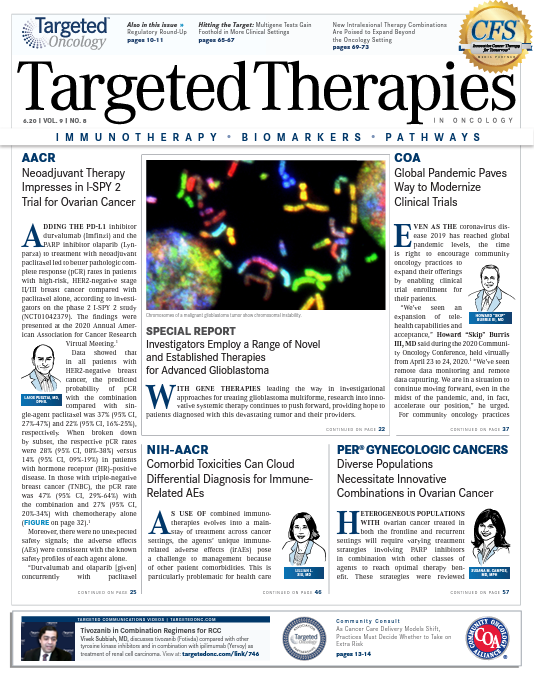Diverse Populations Necessitate Innovative Combinations in Ovarian Cancer
“We are starting to see more and more patients with recurrent ovarian cancer, we’re treating them much more aggressively in the up-front setting, and we have to face PARP inhibitor resistance in the future.”
Susana M. Campos, MD, MPH

Heterogenous populations with ovarian cancer r treated in both the frontline and recurrent settings will require varying treatment strategies involving PARP inhibitors in combination with other classes of agents to reach optimal therapy benefit. These strategies were reviewed during a virtual presentation of the 11th Annual International Symposium on Ovarian Cancer and Other Gynecologic Malignancies™ and hosted by Physicians' Education Resource®, LLC (PER®).1
In the up-front settings, the use of PARP inhibitors is designed to improve progression-free survival (PFS), objective response rates (ORRs), and overall survival (OS). In the recurrent space, the goal with this type of therapy is to improve efficacy, overcome resistance, improve immunogenic response, target multiple oncogenic pathways, and provide options for all patients with ovarian cancer, regardless of their homologous recombination deficiency (HRD) status.
“Even though we have trials with different stratifications, eligibility, and designs, we certainly have a heterogeneous patient population,” said Susana M. Campos, MD, MPH, who presented the data. “We are starting to see more and more patients with recurrent ovarian cancer, we’re treating them much more aggressively in the up-front setting, and we have to face PARP [inhibitor] resistance in the future.”
Frontline Combinations
Investigators have explored the combination of the PARP inhibitor olaparib (Lynparza) and the angiogenesis inhibitor bevacizumab (Avastin) in the frontline maintenance setting for patients with advanced ovarian cancer who are in complete or partial response to first-line platinum-based chemotherapy with bevacizumab. In the double-blind, placebo-controlled, phase 3 PAOLA-1 trial (NCT02477644), patients with newly diagnosed, stage III to IV, high-grade, serous or endometroid ovarian, fallopian tube, or peritoneal cancer were randomized 2:1 to receive olaparib in combination with bevacizumab (n = 537) or bevacizumab with placebo (n = 269) as a f irst-line maintenance treatment.2
Eligible patients had a complete or partial response to frontline platinum-based chemotherapy and bevacizumab, regardless of genetic biomarker status or their outcome with prior surgery. Findings showed that the combination led to a 41% reduction in the risk of disease progression or death compared with bevacizumab alone in this patient population, based on an investigator assessment (HR, 0.59; 95% CI, 0.490.72; P <.0001).2 Additionally, after a median follow-up of 22.9 months, the median progression-free survival (PFS) was 22.1 versus 16.6 months with the combination and bevacizumab alone, respectively. When stratified by somatic BRCA status, the PFS favored the tumors that were BRCA mutant (HR, 0.31; 95% CI, 0.20-0.47) versus those that were not (HR, 0.71; 95% CI, 0.58-0.88).
Results also showed that the benefit with olaparib was most pronounced in patients with tumors positive for HRD, which included tumors with BRCA mutations (HR, 0.33; 95% CI, 0.25-0.45). In this subgroup, the median PFS was 37.2 months with the olaparib combination and 17.7 months with bevacizumab alone, respectively.
Based on the PAOLA-1 data, the FDA expanded the indication of olaparib to include its combination with bevacizumab for the maintenance treatment of patients with advanced ovarian cancer who are in complete or partial response to first-line platinum-based chemotherapy.3
“The PAOLA-1 study did not have an olaparib-only arm,” Campos, a physician at the Dana-Farber Cancer Institute and an assistant professor of medicine at Harvard Medical School, both in Boston, Massachusetts, said of PAOLA-1. “This draws us into the question, ‘What patient population is this combination most appropriate for?’ I bring myself back to, ‘Who would I have put on bevacizumab? What are the data that surround GOG-0218 or ICON7?’”
The phase 3 VELIA trial (NCT02470585), which looked at the investigational agent veliparib, evaluated the addition of a PARP inhibitor to chemotherapy in patients with high-grade serous ovarian cancer. The trial randomized patients evenly among 3 arms: The first arm (control) consisted of carboplatin and paclitaxel with placebo followed by placebo as maintenance (n = 375). The second arm examined the addition of veliparib to carboplatin/paclitaxel as induction therapy, followed by placebo maintenance (n = 383). In the third arm, investigators added veliparib at 150 mg twice daily to carboplatin/paclitaxel followed by veliparib alone at 400 mg twice daily as maintenance (n = 382).
Results showed that the arm of veliparib plus carboplatin/paclitaxel followed by maintenance veliparib led to a 32% reduction in the risk of progression or death versus placebo/chemotherapy with placebo maintenance in the intentionto-treat (ITT) population.4 The median PFS was 23.5 months versus 17.3 months in the placebo arm (HR, 0.68; 95% CI, 0.56-0.83; P <.001).
The benefit was more pronounced in those with BRCA mutations. In this group, the median PFS was 34.7 months compared with 22.0 months for veliparib and placebo, respectively (HR, 0.44; 95% CI, 0.28-0.68; P <.001). In a subset of patients with both BRCA mutations and HRD positivity, the median PFS was 31.9 months with the addition of veliparib and 20.5 months for the control arm (HR, 0.57; 95% CI, 0.43-0.76; P <.001).
In BRCA wild-type patients, the addition of the PARP inhibitor did not demonstrate a PFS benefit versus the control arm, at 18.2 months and 15.1 months, respectively (HR, 0.80; 95% CI, 0.64-0.997). Investigators observed a similar effect in patients with BRCA wild-type/ HRD positivity (HR, 0.74; 95% CI, 0.52-1.06) and HRD negativity (HR, 0.81; 95% CI, 0.60-1.09).
“It draws some questions in terms of the second arm,” said Campos. “If you combine chemotherapy with a PARP inhibitor, do you just add toxicity? Can you, at that point in time, abbreviate the backbone of therapy, which is carboplatin/paclitaxel? We have many different patients; [the combinations in PAOLA-1 and VELIA] may have utility in a particular patient group.”
Regimens for Recurrent Settings
Trials are also evaluating combination strategies using PARP inhibition in the recurrent setting of both patients with platinum-sensitive and platinum-resistant disease. Although Campos explained that combining PARP inhibitors and other agents can present challenges, such as dose-limiting toxicities, she added that opportunities do exist to overcome PARP inhibitor resistance mechanisms and enhance tumor mutational load and immunogenicity.
Some of these studies, which include PARP inhibitors plus antiangiogenic agents, immunotherapy, or chemotherapy, have already reported data showcasing their efficacy, and others are expected to read out in the near future. For example, investigators explored olaparib plus the investigational antiangiogenic agent cediranib in a small phase 2 trial (NCT01116648) of 90 patients with platinum-sensitive, relapsed, high-grade serous or endometrioid ovarian, fallopian tube, or primary peritoneal cancer, as well as other histologies with deleterious germline BRCA1/2 mutations. Updated findings showed that in the ITT population, the median PFS was 16.5 versus 8.2 months with the combination and olaparib alone, respectively (HR, 0.50; 95% CI, 0.30-0.83; P = .007).5 The median OS was also improved with the combination, at 44.2 versus 33.3 months with olaparib alone (HR, 0.64; 95% CI, 0.36-1.11; P = .11).
When stratified by somatic BRCA mutation status, the median PFS was 23.7 months with olaparib/cediranib and 5.7 months with olaparib alone in those who did not harbor somatic BRCA mutations (HR, 0.32; 95% CI, 0.16-0.66; P = .002). However, this improvement was not mirrored in the somatic BRCA-mutant carrier subgroup (median PFS, 16.4 months and 16.5 months, respectively; HR, 0.75; 95% CI, 0.38-1.49; P = .42).
Similarly, the AVANOVA study investigated the PARP inhibitor niraparib (Zejula) in combination with bevacizumab versus niraparib alone (NCT02354131). The regimen was tested in patients with high-grade serous, endometrioid, platinum-sensitive recurrent ovarian cancer who could have received any number of prior therapies. Data showed that the median PFS was 11.9 months with niraparib/bevacizumab and 5.5 months with single-agent niraparib (adjusted HR, 0.35; 95% CI, 0.21-0.57; P <.0001).6 The combination improved PFS regardless of HRD positivity (HR, 0.38; 95% CI, 0.20-0.72; P = .0019) or negativity (HR, 0.40; 95% CI, 0.19-0.85; P = .0129).
PARP Plus Immunotherapy
Although response rates and PFS with single-agent immunotherapy in ovarian cancer have historically been “less than exciting,” said Campos, intriguing research has demonstrated synergy when PD-1/PD-L1 inhibitors are partnered with PARP inhibitors.
Results of smaller studies have shown preliminary efficacy with these types of regimens in different ovarian cancer populations. In the phase 2 MEDIOLA trial (NCT02734004), for example, durvalumab (Imfinzi) plus olaparib led to a 71.9% ORR in a germline BRCA-mutant, platinum-sensitive population (n = 35).7 Yet the phase 1/2 TOPACIO trial (n = 60) of pembrolizumab (Keytruda) and niraparib had a more modest ORR at 25%, with a median duration of response of 9.3 months (NCT02657889).8 Results of another small trial of durvalumab plus olaparib (n = 35) showed that the combination had a modest ORR in a population with mostly platinum-resistant recurrent ovarian cancer.9
Beyond doublet regimens, investigators are also beginning to evaluate triplet therapies with all 3 classes of agents, as in the phase 2 OPAL study (NCT03574779) with niraparib, TSR-042, a PD-1 inhibitor, and bevacizumab in patients with recurrent, platinum-resistant, ovarian, fallopian tube, or peritoneal cancer.
Emerging Targets
There has been a “tremendous amount of interest” in looking at other emerging combinations in terms of DNA damage–repair targets and other agents, Campos explained, citing Wee-1, PI3K/Akt/mTOR, ATR, Chk1, and MEK all as targets that a number of trials are exploring.
For example, investigators are exploring the Wee-1 inhibitor adavosertib (AZD1775) with and without olaparib in the phase 2 EFFORT trial (NCT03579316) of patients with recurrent ovarian, primary peritoneal, or fallopian tube cancer. Activated Wee-1 phosphorylates CDK1, Campos said, and therefore results in G2-M arrest.
Additionally, the MEK inhibitor selumetinib (Koselugo) is also being combined with olaparib in a phase 1 trial (NCT03162627) of patients with recurrent solid tumors, including ovarian cancer. The addition of MEK inhibitors to PARP could decrease homologous recombination repair gene expression, Campos said.
“In a short period of time, there is a tremendous amount of work,” Campos concluded. “
References:
1. Campos S. Incorporating combination therapy in an evolving treatment landscape. Presented at: 11th Annual International Symposium on Ovarian Cancer and Other Gynecologic Malignancies™; May 2, 2020.
2. Ray-Coquard I, Pautier P, Pignata S, et al; PAOLA-1 Investigators. Olaparib plus bevacizumab as first-line maintenance in ovarian cancer. N Eng J Med. 2019;381(25):2416-2428. doi:10.1056/NEJMoa1911361
3. FDA approves olaparib plus bevacizumab as maintenance treatment for ovarian, fallopian tube, or primary peritoneal cancers. FDA. Updated May 11, 2020. Accessed May 12, 2020. https://bit.ly/3dGTQiv
4. Coleman RL, Fleming GF, Brady MF, et al. Veliparib with first-line chemotherapy and as maintenance therapy in ovarian cancer. N Engl J Med. 2019;381(25):2403-2415. doi:10.1056/NEJMoa1909707
5. Liu JF, Barry WT, Birrer MJ, et al. Overall survival and updated progression-free survival results from a randomized phase 2 trial comparing the combination of olaparib and cediranib against olaparib alone in recurrent platinum-sensitive ovarian cancer. J Clin Oncol. 2017;35(suppl 15):5535. doi:10.1200/JCO.2017.35.15_suppl.5535
6. Mirza MR, Åvall Lundqvist E, Birrer MJ, et al. Niraparib plus bevacizumab versus niraparib alone for platinum-sensitive recurrent ovarian cancer (NSGO-AVANOVA2/ENGOT-ov24): a randomised, phase 2, superiority trial. Lancet Oncol. 2019;20(10):1409-1419. doi:10.1016/S1470-2045(19)30515-7
7. Drew Y, Kaufman B, Banerjee S, et al. Phase II study of olaparib + durvalumab (MEDIOLA): updated results in germline BRCA-mutated platinum-sensitive relapsed (PSR) ovarian cancer (OC). Ann Oncol. 2019;30(suppl 5):v485-v486. doi: 10.1093/annonc/mdz253.016
8. Konstantinopoulos PA, Waggoner SE, Vidal GA, et al. TOPACIO/Keynote-162 (NCT02657889): a phase 1/2 study of niraparib + pembrolizumab in patients (pts) with advanced triple-negative breast cancer or recurrent ovarian cancer (ROC)—results from ROC cohort. J Clin Oncol. 2018;36(suppl 15):106. doi:10.1200/JCO.2018.36.15_suppl.106
9. Lee J-M, Annunziata CM, Houston N, et al. A phase 2 study of durvalumab, a PD-L1 inhibitor and olaparib in recurrent ovarian cancer (ovca). Ann Oncol. 2018;29(suppl 8):viii332-viii358. doi:10.1093/annonc/mdy285

Survivorship Care Promotes Evidence-Based Approaches for Quality of Life and Beyond
March 21st 2025Frank J. Penedo, PhD, explains the challenges of survivorship care for patients with cancer and how he implements programs to support patients’ emotional, physical, and practical needs.
Read More